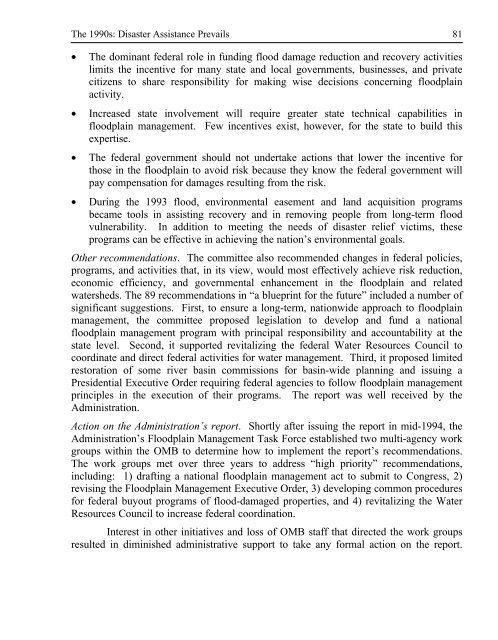The Nation's Responses To Flood Disasters: A Historical Account
The Nation's Responses To Flood Disasters: A Historical Account
The Nation's Responses To Flood Disasters: A Historical Account
Create successful ePaper yourself
Turn your PDF publications into a flip-book with our unique Google optimized e-Paper software.
<strong>The</strong> 1990s: Disaster Assistance Prevails 81<br />
• <strong>The</strong> dominant federal role in funding flood damage reduction and recovery activities<br />
limits the incentive for many state and local governments, businesses, and private<br />
citizens to share responsibility for making wise decisions concerning floodplain<br />
activity.<br />
• Increased state involvement will require greater state technical capabilities in<br />
floodplain management. Few incentives exist, however, for the state to build this<br />
expertise.<br />
• <strong>The</strong> federal government should not undertake actions that lower the incentive for<br />
those in the floodplain to avoid risk because they know the federal government will<br />
pay compensation for damages resulting from the risk.<br />
• During the 1993 flood, environmental easement and land acquisition programs<br />
became tools in assisting recovery and in removing people from long-term flood<br />
vulnerability. In addition to meeting the needs of disaster relief victims, these<br />
programs can be effective in achieving the nation’s environmental goals.<br />
Other recommendations. <strong>The</strong> committee also recommended changes in federal policies,<br />
programs, and activities that, in its view, would most effectively achieve risk reduction,<br />
economic efficiency, and governmental enhancement in the floodplain and related<br />
watersheds. <strong>The</strong> 89 recommendations in “a blueprint for the future” included a number of<br />
significant suggestions. First, to ensure a long-term, nationwide approach to floodplain<br />
management, the committee proposed legislation to develop and fund a national<br />
floodplain management program with principal responsibility and accountability at the<br />
state level. Second, it supported revitalizing the federal Water Resources Council to<br />
coordinate and direct federal activities for water management. Third, it proposed limited<br />
restoration of some river basin commissions for basin-wide planning and issuing a<br />
Presidential Executive Order requiring federal agencies to follow floodplain management<br />
principles in the execution of their programs. <strong>The</strong> report was well received by the<br />
Administration.<br />
Action on the Administration’s report. Shortly after issuing the report in mid-1994, the<br />
Administration’s <strong>Flood</strong>plain Management Task Force established two multi-agency work<br />
groups within the OMB to determine how to implement the report’s recommendations.<br />
<strong>The</strong> work groups met over three years to address “high priority” recommendations,<br />
including: 1) drafting a national floodplain management act to submit to Congress, 2)<br />
revising the <strong>Flood</strong>plain Management Executive Order, 3) developing common procedures<br />
for federal buyout programs of flood-damaged properties, and 4) revitalizing the Water<br />
Resources Council to increase federal coordination.<br />
Interest in other initiatives and loss of OMB staff that directed the work groups<br />
resulted in diminished administrative support to take any formal action on the report.
















